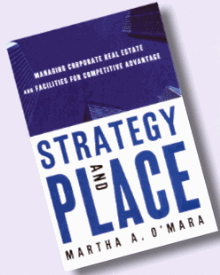An article appears in a recent edition of The Journal of Corporate Real Estate, entitled “Strategies for Demand Forecasting in Corporate Real Estate Portfolio Management” (Henry Stewart Publications, Vol. 2, No. 2, pps. 123 to 137) in which Martha O’Mara, Ph.D., discusses the Alliance’s research findings. O’Mara (left) is a lecturer in executive education at the Harvard Design School and author of “Strategy and Place: Managing Corporate Real Estate and Facilities for Competitive Advantage” (The Free Press, 1999).
Of all the management skills required of today’s corporate real estate manager, none is more elusive than the requirement that he have soothsaying skills. After all, predicting real estate space requirements is central to an organization’s ability to manage physical assets wisely and, as importantly, strategically.
Real estate clairvoyance is known in professional circles as demand forecasting, which is an area gaining considerable attention as the strategic role of real estate becomes more accepted, or understood, in the executive offices. In some ways, it’s been there all along insofar as successful space demand forecasting is an end product of such pursuits as benchmarking of workspace performance, corporate infrastructure management and portfolio management.
The discipline is gaining even more stature now as research into real estate demand forecasting is made available that puts flesh on the conceptual skeleton. A case in point is work done by the Corporate Real Estate Portfolio Alliance in the area of demand forecasting first referenced in a Site Selection article on the Alliance’s work in the March 2000 issue (“Industry Alliance Hammers Out a New Portfolio Management Model,” pg. 218). Important New Literature
Important New Literature

Classic forecasting methods assume continuity of conditions, O’Mara relates in the article, an abstract of which was made available to Site Selection in the spring. The key difference for corporate real estate is that the underlying demand for space can be radically shifted by discontinuous changes in the company structure, ownership, technology and by management initiatives. The Alliance studied numerous forecasting methods and concluded that those most relative to corporate real estate forecasting are those with an element of managerial judgment due to the qualitative factors tied to the demand for and supply of real estate. Equally important to note is the observation that there is no single best forecasting method; several can be used, and forecasting improvement results must be gained incrementally.
Martha O’Mara’s 1999 book, Strategy and Place, already in its third printing, offers a well-marked roadmap for organizations seeking ways to think about their real estate and facilities management operations strategically. Noted Harvard Business School’s Rosabeth Moss Kanter, prior to publication, ” Martha O’Mara is a pioneer in illuminating the organizational, cultural and performance implications of corporate facilities.”
Forecasting Model Debuts
The fruit of the Alliance’s research and the heart of the resulting article is the introduction of a four-stage model of demand forecasting. “Each successive stage relies on more abstract data and greater strategic dialog with the lines of business as uncertainty increases,” O’Mara’s article explains. “Each stage requires increasing flexibility in the supply of real estate as the range of probabilities around the forecast widens.”
Stage One: Direct Translation of Business Data. This stage identifies and projects employee population growth based on actual business data. Analysis of the data should include knowledge of property inventory, tracking of population changes, real estate occupancy and performance metrics and data on changes in usage of space over time. This analysis can be conducted by either the lines of business or by the corporate real estate group; the article outlines the pros and cons associated with either approach.
Stage Two: Extrapolation from Business Indicators. This stage looks beyond published data to project requirements further than a year to 18 months in order to generate estimates that are based on the business plan. “In Stage Two, it is useful to identify decision horizons — that is, at what points commitments of capital must be made,” O’Mara’s article relates. “This can be done by segmenting the decisions that must be made now, such as renewing a lease or optioning a parcel of land, to decisions that can be made at a later date when information is more certain, such as the actual beginning of construction.”
Central to successful Stage Two forecasting is a good relationship with the businesses, which requires strong relationship management skills on the part of the corporate real estate manager. “Relationship management improves demand forecast reliability by obtaining strategic planning information earlier, improving the delivery of services to the business units by offering one-stop shopping, and improves control over corporate assets by more closely monitoring business unit activity with its space.”
Stage Three: Scenario Testing. This stage of forecasting helps formulate plans for three-to-five-year horizons. Scenario testing is a what-if exercise, where various plans based on a range of business conditions are explored.
“For effective real estate scenario planning, the costs and risks associated with each outcome must be determined,” the Alliance research concluded. “This should also include the costs of not having enough space (crowding, high churn, loss of c-location and critical adjacencies), the costs of incrementally acquiring additional space beyond what is planned, as well as the more obvious costs of having too much space.”
Work done at the third stage should be conducted at the business unit level, not just at the portfolio level, O’Mara stresses. “While demand may look predictable and smooth when all business properties are aggregated, there may actually be a great deal of turbulence in demand at the business unit level. What looks like available space on a spreadsheet may actually be either the wrong space or be in the wrong place. Identifying demand clusters can help avoid this problem.”
Stage Four: Un-forecasting. This stage addresses the inherent limits in forecasting; it widens the range of variance tolerated in the forecast. “The goal is to increase options on the supply side to buffer uncertainty on the demand side,” O’Mara explains. Un-forecasting is most useful for high-growth companies and those experiencing major changes in how they use real estate. “Supply flexibility is also important to companies who may be migrating to a lower-cost position, because some part of the business may still be experiencing higher rates of less-predictable growth.”
This stage addresses the importance of portfolio supply flexibility, of which there are traditional and non-traditional sources. Traditional sources include lease terms and strategies for delaying the commitment to space as long as possible. Non-traditional sources of flexibility include alternative officing methods.
The Corporate Real Estate Portfolio Alliance’s demand forecasting research is far more comprehensive than can be illuminated here. But O’Mara’s summary captures both the spirit of the group’s in-depth research and its practical application in the corporate real estate profession.

